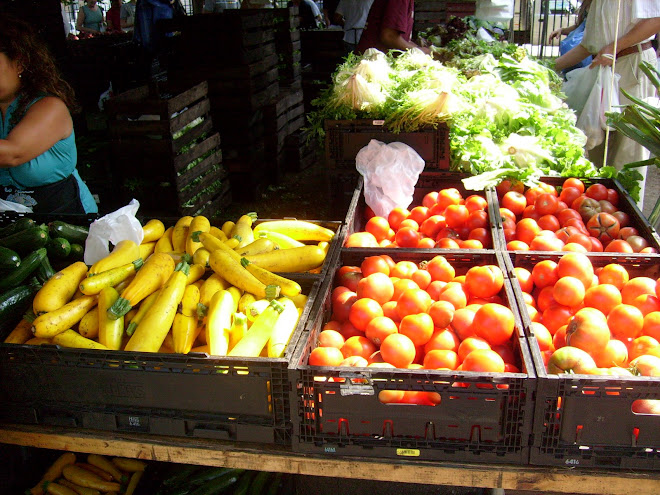The Africa Cookbook, by Jessica B. Harris isn't a bad book. It's actually quite interesting, offering lore, history, and tradition in the beginning and throughout the recipe sections. What it doesn't have is a collection of the fabulous, specifically Ethiopian dishes I have had a few times now and daydream about (I mean it, I really dream of these--It's so good.) It has not much at all regarding making your own injera bread. I assumed that since Ethiopian food is the most famous of African cuisines that it would be featured and highlighted more. Not so. While most of the recipes are interesting combinations of meats, fish, calabaza squash, peanuts, tomatoes, greens, and grains, that's all most of it is. Just braised stuff. No exciting spice blends, no exotic procedure to learn, and no perfectly seasoned gourmet African dish. Silly me. This book is actually authentic!
So, I surrendered to the book and chose two recipes, one beef and one vegetable and decide to try them out. I made them today so after a busy Thursday (tomorrow), we will have a good dinner ready to go. Well...here's how it went.
First off, I would like to say that the biggest thing I learned is that Ethiopian food is drastically different than most other African cuisines. The vegetable recipe I chose was Ethiopian, but the beef recipe was from Congo and had NO seasonings. I just had to add more salt, along with a few teaspoons dried ginger, some garlic powder, and some sweet paprika. I had to. They are seemingly "safe"additions that I thought I could add without totally de-Congo-ing the dish, but I probably did. I have no clue what people eat in the Congo.
The vegetable dish turned out great, but....it was an okra dish and I looked everywhere and could not find a fresh okra pod in Greenpoint to save my life. (I will be really annoyed if I see some tomorrow in Manhattan when I'm working.) Anyway, I substituted collard greens because I knew that they were also a common Ethiopian ingredient. What the hell, right?
So I followed the recipes with all of the above in mind, if you can even call that following the recipes. You know what? It's going to be a great meal. The veggies are so very simple and taste amazing. The beef needs to stew a bit longer tomorrow and I may add some cayenne and/or curry powder depending on how the flavors blend overnight. Not bad for a seemingly losing battle of incorrect African regions, lack of seasoning, and an okra-free Brooklyn.
Here are the recipes. If you try them and add something exciting, please post it!
Ethiopian-Style Okra (or collards if you're me) OR Bamya Alich'A
4 cups young okra pods
1/4 cup olive oil
1 1/2 cups minced red onions
2 cups coarsely chopped, seeded peeled ripe tomatoes
2 teaspoons minced garlic
2 teaspoons minced ginger
1/2 teaspoon ground cardamom
2 jalapeno chiles, minced, or to taste
Wash and top and tail the okra, discarding any blemished or hard pods (or wash and spin your collard and roughly chop them ; ) Split each pod in half lengthwise. Heat the oil in a medium saucepan and cook the onions until they are light brown. Add the tomatoes and bring the mixture to a boil. Lower the okra, cook, uncovered, over low heat for 20 minutes, then add the chiles and continue to cook for 5 minutes. **Adjust the seasoning and remove from the heat. Serve hot or at room temperature.
**I added salt and extra cardamom and finished the dish with a healthy squirt of fresh lemon juice.
THIS IS REALLY GOOD!!
Mwambe Beef (Congo)
serves 4 to 6
3 lb beef, cut into 1-inch pieces
1 tablespoon freshly squeezed lemon juice
1/2 teaspoon salt
2 tablespoons peanut oil (I used fragrant peanut oil--healthier and tastier!)
2 large onions, chopped
1/8 teaspoon habanero chile (I used 1/2 jalapeno)
7 medium-sized ripe tomatoes, peeled, seeded, coarsely chopped (I used 1/2 fresh, 1/2 canned)
4 cups water
Rub the beef pieces with the lemon juice and salt. Heat the oil in a heavy stockpot or Dutch oven, add the beef and the onions, and cook until the onions are translucent and the beef is lightly browned. (Here is where I added ginger, garlic, and paprika. I think dried mint or cilantro and also some garam masala or a pinch of cloves would also be a nice addition--get creative.) Add the remaining ingredients, lower the heat, cover, and cook for 1 1/2 hours, or until the beef is fork-tender. Serve hot with white rice.










2 comments:
The veg dish looks really tempting. I will try it and let you know how it turns out. I concur with your inclination to add more spices to the meat dish.
The African recipes I have tried come from Marcus Samuelsson's book The Soul of a New Cuisine. He is Ethiopian by birth and a great chef so the viewpoint is a syntheses of his experiences, and the photos are gorgeous.
Thank you for continuing to explore this region. I can't wait to see what is next!
Thanks for the recommendation, Deb! I will definitely check out that book. What's next? Probably Ethiopian. The Africa Cookbook will have to go back to the bookshelf while I get some serious Ethiopian food going!!!
Post a Comment